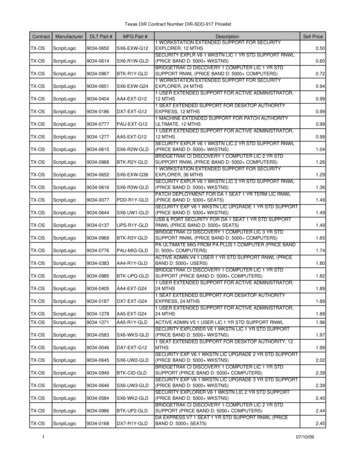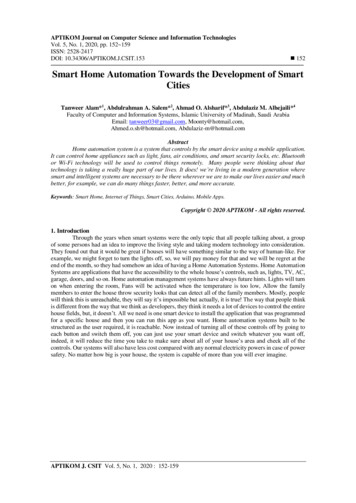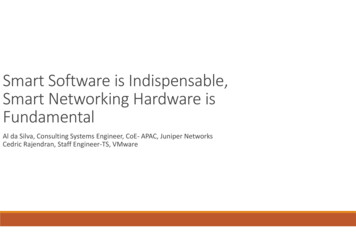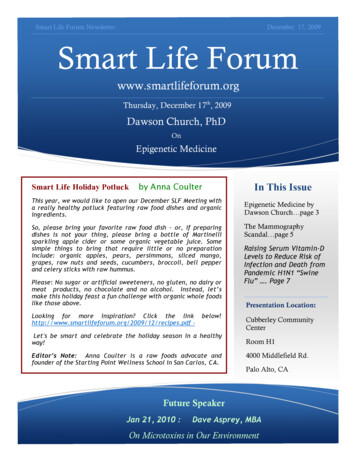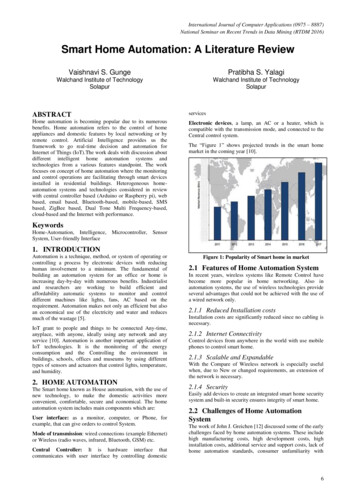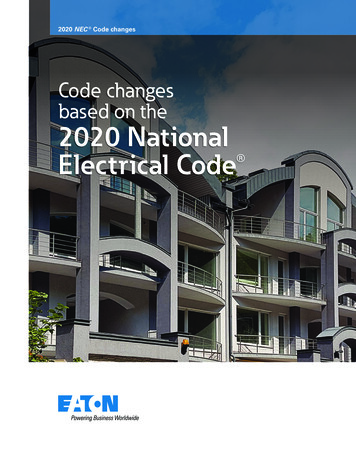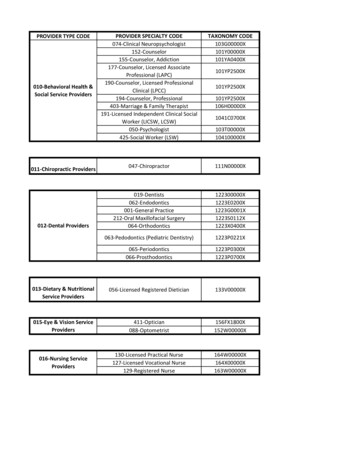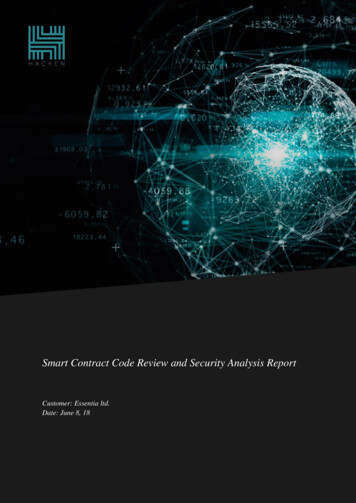
Transcription
Smart Contract Code Review and Security Analysis ReportCustomer: Essentia ltd.Date: June 8, 18
1This document contains confidential information about IT systems andintellectual properties of the customer, as well as information aboutpotential vulnerabilities and methods of their exploitation.This confidential information is for internal use by the customer only andshall not be disclosed to third parties.Document:Name:Smart Contract Code Review and SecurityAnalysis Report for Essentia ltd.Date:08.06.2018
2Table of contentsIntroduction.3Scope.3Executive Summary .4Severity Definitions .4AS-IS overview .5Audit overview .6Conclusion .9Disclaimers .9Appendix A. Evidences .10Appendix B. Automated reviews .12
3IntroductionHacken OÜ (Consultant) was contracted by Essentia ltd. (Customer) to conduct a Smart ContractCode Review and Security Analysis. This report presents the findings of the security assessment ofCustomer s smart contract and its code review conducted between June 5th, 2018 - June 8th, 2018.ScopeThe scope of the project is Essentia smart contract, which can be found by link 89accf0f509e44b0145d68240f7#codeThis smart contract consists of: contract Ownable contract ESSENTIA ERC20 contract ESSENTIA interface tokenRecipient library SafeMathWe have scanned these smart contracts for commonly known and more specific vulnerabilities.Here are some of the commonly known vulnerabilities that are considered (the full list includesthem but is not limited to them): ReentrancyTimestamp DependenceGas Limit and LoopsDoS with (Unexpected) ThrowDoS with Block Gas LimitTransaction-Ordering DependenceByte array vulnerabilitiesStyle guide violationTransfer forwards all gasERC20 API violationMalicious librariesCompiler version not fixedUnchecked external call - Unchecked mathUnsafe type inferenceImplicit visibility level
4Executive SummaryAccording to the assessment, Customer s smart contract is generally secure with some possibilitiesfor improvement.Our team performed code review, manual audit and automated checks with solc, Mythrill and remixIDE (see Appendix B pic 1-4). General overview is presented in AS-IS section and all found issuescan be found in Audit overview section.We found 3 security issues and 11 cases of violation of the code style guide, however, no critical,high or medium severity vulnerabilities were found.Graph 1. Vulnerabilities distributionLow7%Lowest14%Code StyleViolations79%LowLowestCode Style ViolationsSeverity DefinitionsRisk LevelCriticalDescriptionCritical vulnerabilities are usually straightforward to exploit and can leadto tokens lose etc.HighHigh-level vulnerabilities are difficult to exploit; however, they also havesignificant impact on smart contract execution, e.g. public access to crucialfunctionsMediumMedium-level vulnerabilities are important to fix; however, they can’t leadto tokens loseLowLowest / CodeStyle / InfoLow-level vulnerabilities are mostly related to outdated, unused etc.code snippets, that can’t have significant impact on executionLowest-level vulnerabilities, code style violations and info statementscan’t affect smart contract execution and can be ignored.
5AS-IS overviewOwnable contract describes basic access control with owner role which is an actual address whatcontrol the smart contract.ESSENTIA ERC20 contract describes custom ERC20 token with next parameters:1. standard - ESSENTIA erc20 and Genesis2. decimals – 183. name – ESSENTIA4. symbol - ESS5. Total supply of token is only declaredESSENTIA contract is ESSENTIA ERC20 contract, which defines 2 addresses A and B, that arehardcoded and hold all the tokens after constructor called. The balances of accounts are: address A – 614359681000000000000000000 tokens address B – 1140953692000000000000000000 tokensTotal supply is 1755313373000000000000000000 ESS tokens.The functionality of ESSENTIA contract is grouped by access – functions with public access andfunction with only owner access (address owner can only run functions with onlyOwner modifier).Public functions are: balanceOf – view that returns balance of the account transfer – allows to transfer token to some account transferFrom – allows to transfer token to some account from some other account ifmsg.sender has an allowance approve – changes the allowance for account to some value allowance – view that returns allowance for pair of owner and spender accounts increaseApproval – allows to increase the allowance for some account decreaseApproval – allows to decrease the allowance for some account approveAndCall – allows to approve and then communicate the approved contractonlyOwner function is only transferOwnership to transfer ownership of the contract.tokenRecipient interface is declaring the required functions and events to meet the ERC20 standardto be able to send tokens to the contract.SafeMath library overwrites math operations with safety checks that throw on error.
6Audit overviewCriticalNo critical severity vulnerabilities were found.HighNo critical severity vulnerabilities were found.MediumNo medium severity vulnerabilities were found.LowOverall1. Compiler version is not locked. Consider locking the compiler version with latest one (seeAppendix A pic 1 for evidence).pragma solidity 0.4.24; // bad: compiles w 0.4.24 and abovepragma solidity 0.4.24; // good: compiles w 0.4.24 onlyLowest / Code style / InfoContract ESSENTIA2. A and B addresses are hardcoded and their naming is unclear one (see Appendix A pic 2 forevidence). Consider adding functionality for management of these addresses – setting,changing etc. Consider also changing the name of accounts and adding a description aboutthem in comments.3. Contract contains some redundant code on lines 207 and 208 (see Appendix A pic 3 forevidence). Consider rewriting the code as described below.balances[A] ;balances[B] );TObalances[A] 614359681 * (uint256(10) ** decimals);balances[B] 1140953692 * (uint256(10) ** decimals);
7Code style issues6. Library SafeMath is defined on lines 24-51 without any comments or descriptions. It wascopied from OpenZeppelin SafeMath – library that is considered secure by community.Consider adding comments about the origin of the library or importing it fromOpenZeppelin repository.7. Contract Ownable is defined on lines 55-75 without any comments or descriptions. It wascopied from older version of OpenZeppelin Ownable contract – library that is consideredsecure by community. Consider adding comments about the origin of the contract orimporting it from OpenZeppelin repository.8. Contract ESSENTIA ERC20 is defined on lines 88-182 without any comments ordescriptions for functions. All the functions were copied from OpenZeppelin contracts thatare considered secure by community. Consider adding comments about the origin of thefunction and their functionality, for instance, like described below/*** @dev Transfer tokens from one address to another* @param from address The address which you want to send tokens from* @param to address The address which you want to transfer to* @param value uint256 the amount of tokens to be transferred*/function transferFrom(address from,address to,uint256 value)publicreturns (bool){require( to ! address(0));require( value balances[ from]);require( value allowed[ from][msg.sender]);balances[ from] balances[ from].sub( value);balances[ to] balances[ to].add( value);allowed[ from][msg.sender] allowed[ from][msg.sender].sub( value);emit Transfer( from, to, value);return true;}9. tokenRecipient interface doesn’t have any description in comments. Consider addingdescription of interface functionality in comments.10. ESSENTIA contract doesn’t have any description in comments. Consider adding descriptionof contract in comments.
811. Constant names are not in SNAKE CASE (see lines 101, 102). Consider usingSNAKE CASE for constants.12. Contract names are not in CamelCase (see lines 88, 186). Consider using CamelCase forconstants.13. No spaces near math expressions (see lines 207, 208, 210). Consider adding spaces nearmath operators like “ ”, “ ”, “**” etc.14. 4 extra spaces on lines 195, 196. Consider removing extra spaces.15. Semicolon has spaces before itself on line 187. Consider removing space before semicolon.16. Definition is not surrounded with two blank line indents on lines 24, 55, 88, 186, 192.
9ConclusionDuring the audit all the contracts were manually reviewed and analyzed with static analysis tools.As-is description was described.Audit report contains all found security vulnerabilities and code style guide violations in thereviewed code.Overall quality of reviewed contracts is good and no global changes are needed. However, 3 low tolowest security issues were found that are needed to be fixed.DisclaimersDisclaimerThe audit does not give any warranties on the security of the code. One audit cannot be consideredenough. We always recommend proceeding to several independent audits and a public bug bountyprogram to ensure the security of the smart contracts.Technical DisclaimerSmart contract build on the top of Ethereum blockchain means that a lot of features could becovered by tests, but Turing completeness of Solidity programming language realization leavessome space for unexpected runtime exceptions.
10Appendix A. EvidencesPic 1. Compiler version is not locked:Pic 2. Unclear address naming and hardcoded addresses:
11Pic 3. Redundant code on lines 207-208:
12Appendix B. Automated reviewsPic 1. Solc automated reportPic 2. Mythrill automated reportPic 3. Remix IDE automated report part 1Pic 4. Remix IDE automated report part 2
Code Review and Security Analysis. This report presents the findings of the security assessment of Customer s smart contract and its code review conducted between June 5th, 2018 - June 8th, 2018. Scope The scope of the project is Essentia smart contract, which can
